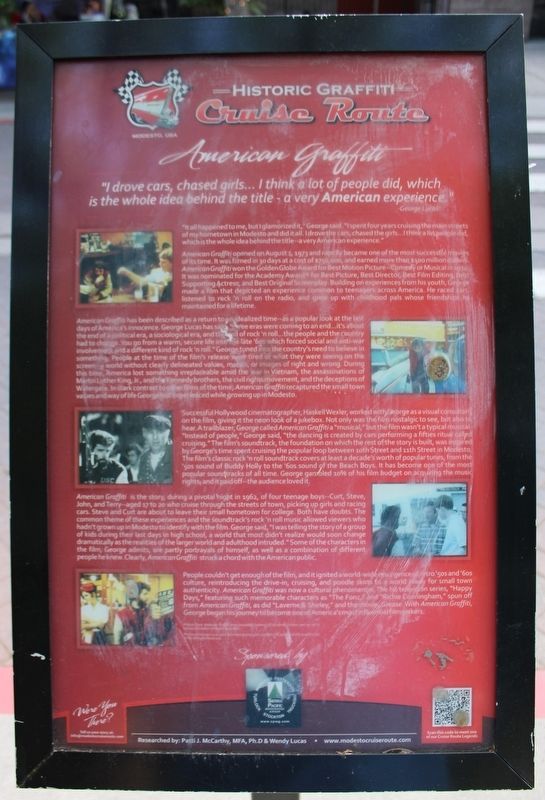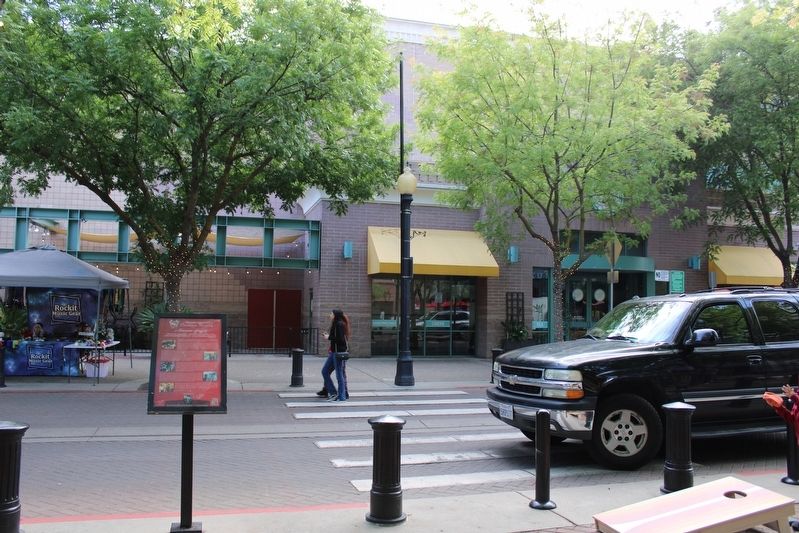Modesto in Stanislaus County, California — The American West (Pacific Coastal)
American Graffiti
Historic Graffiti Cruise Route
"It all happened to me, but I glamorized it, "George said. "I spent four years cruising the main streets of my hometown in Modesto and did it all. I drove the cars, chased the girls...I think a lot people did, which is the whole idea behind the title--a very American experience."
American Graffiti opened on August 1, 1973 and rapidly became one of the most successful movies of its time. It was filmed in 30 days at a cost of $750,000, and earned more than $100 million dollars. American Graffiti won the Golden Globe Award for Best Motion Picture--Comedy or Musical in 1974. It was nominated for the Academy Award for Best Picture, Best Director, Best Film Editing, Best Supporting Actress, and Best Original Screenplay. Building on experiences from his youth, George made a film that depicted an experience common to teenagers across America. He raced cars, listened to rock 'n roll on the radio, and grew up with childhood pals whose friendships he maintained for a lifetime.
American Graffiti has been described as a return to an idealized time--as a popular look at the last days of America's innocence. George Lucas has said, “three eras were coming to an end...it's about the end of a political era, a sociological era, and the end of rock 'n roll... the people and the country had to change. You go from a warm, secure life into the late '60s which forced social and anti-war involvement and a different kind of rock 'n roll." George tuned into the country's need to believe in something. People at the time of the film's release were tired of what they were seeing on the screen, a world without clearly delineated values, morals, or images of right and wrong. During this time, America lost something irreplaceable amid the war in Vietnam, the assassinations of Martin Luther King, Jr., and the Kennedy brothers, the civil rights movement, and the deceptions of Watergate. In stark contrast to other films of the time, American Graffiti recaptured the small town values and way of life George had experienced while growing up in Modesto.
Successful Hollywood cinematographer, Haskell Wexler, worked with George as a visual consultant on the film, giving it the neon look of a jukebox. Not only was the film nostalgic to see, but also to hear. A trailblazer, George called American Graffiti a "musical," but the film wasn't a typical musical. "Instead of people," George said, "the dancing is created by cars performing a fifties ritual called cruising." The film's soundtrack, the foundation on which the rest of the story is built, was inspired by George's time spent cruising the popular loop between 10th Street and 11th Street in Modesto. The film's classic rock 'n roll soundtrack covers at least a decade's worth of popular tunes, from the '50s sound of Buddy Holly to the '60s sound of the Beach Boys. It has become one of the most popular soundtracks of all time. George gambled 10% of his film budget on acquiring the music rights, and it paid off--the audience loved it.
American Graffiti is the story, during a pivotal night in 1962, of four teenage boys--Curt, Steve, John, and Terry--aged 17 to 20 who cruise through the streets of town, picking up girls and racing cars. Steve and Curt are about to leave their small hometown for college. Both have doubts. The common theme of these experiences and the soundtrack's rock 'n roll music allowed viewers who hadn't grown up in Modesto to identify with the film. George said, "I was telling the story of a group of kids during their last days in high school, a world that most didn't realize would soon change dramatically as the realities of the larger world and adulthood intruded." Some of the characters in the film, George admits, are partly portrayals of himself, as well as a combination of different people he knew. Clearly, American Graffiti struck a chord with the American public.
People couldn't get enough of the film, and it ignited a world-wide resurgence of retro '50s and '60s culture, reintroducing the drive-in, cruising, and poodle skirt to world ready for small town authenticity. American Graffiti was now a cultural phenomenon. The hit television series, "Happy Days," featuring such memorable characters as "The Fonz” and “Richie Cunningham," spun off from American Graffiti, as did "Laverne & Shirley," and the movie Grease. With American Graffiti, George began his journey to become one of America's most influential filmmakers.
Were You There? Tell is your story at: [email protected]
Researched by: Chris Murphy • www.ModestoCruiseRoute.com
Erected by Modesto Convention & Visitor's Bureau.
Topics and series. This historical marker is listed in these topic lists: Arts, Letters, Music • Entertainment • Roads & Vehicles. In addition, it is included in the Historic Graffiti Cruise Route series list. A significant historical date for this entry is August 1, 1973.
Location. 37° 38.451′ N, 121° 0.039′ W. Marker is in Modesto, California, in Stanislaus County. Marker is on 10th Street north of J Street. The resin marker is mounted to a metal post at the sidewalk. Touch for map. Marker is in this post office area: Modesto CA 95354, United States of America. Touch for directions.
Other nearby markers. At least 8 other markers are within walking distance of this marker. History of Modesto (a few steps from this marker); Evolution of the Cruise Route (within shouting distance of this marker); Movie Theaters – Then and Now (within shouting distance of this marker); Nightclubs and Dancehalls of the 50s and 60s (within shouting distance of this marker); The Modesto Community Experience (about 300 feet away, measured in a direct line); Local Lucas History (about 300 feet away); Drag Racing (about 400 feet away); Bart Bartoni - The Godfather of 10th St (about 400 feet away). Touch for a list and map of all markers in Modesto.
Also see . . . Modesto USA.
""American Graffiti" was the first big film from Modesto native George Lucas. This music-themed night on the town in 1962 lit a fire that created the nostalgia movement of the 1970s and ‘80s, leading to the resurgence of ‘50s music and hit TV series like "Happy Days;" and it all started right here in Modesto, USA."(Submitted on June 28, 2023, by Joseph Alvarado of Livermore, California.)
Credits. This page was last revised on June 28, 2023. It was originally submitted on June 28, 2023, by Joseph Alvarado of Livermore, California. This page has been viewed 73 times since then and 12 times this year. Photos: 1, 2. submitted on June 28, 2023, by Joseph Alvarado of Livermore, California.

